Cranial nerves diseases - Study guides, Class notes & Summaries
Looking for the best study guides, study notes and summaries about Cranial nerves diseases? On this page you'll find 1143 study documents about Cranial nerves diseases.
Page 4 out of 1.143 results
Sort by
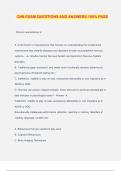
-
CNN EXAM QUESTIONS AND ANSWERS 100% PASS
- Exam (elaborations) • 32 pages • 2024
-
- $13.49
- + learn more
CNN EXAM QUESTIONS AND ANSWERS 100% PASS Clinical neuroscience is: A. Is the branch of neuroscience that focuses on understanding the fundamental mechanisms that underlie diseases and disorders of brain and peripheral nervous systems - i.e. includes Central Nervous System and Autonomic Nervous System disorders. B. Traditional paper and pencil, and newer more functionally dynamic behavioural psychophysics (threshold testing etc.) C. Inattention, inability to stay on task, excessively dist...
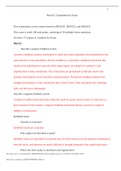
-
BIOS 255 Week 8 Comprehensive Exam (50 MCQs) | 100% CORRECT ANSWERS
- Exam (elaborations) • 7 pages • 2022
-
Available in package deal
-
- $12.49
- 7x sold
- + learn more
Bios255, Comprehensive Exam This examination covers content learned in BIOS251, BIOS252, and BIOS255. This exam is worth 100 total points, consisting of 50 multiple-choice questions. You have 75 minutes to complete the Exam. Bios251 Describe a positive feedback system A positive feedback system is mechanism in which the system responds to the perturbation in the same direction as the perturbation. Positive feedback is essentially a feedback mechanism that results in the amplification or growth o...
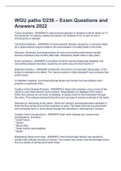
-
WGU patho D236 – Exam Questions and Answers 2022
- Exam (elaborations) • 15 pages • 2022
-
- $9.99
- 2x sold
- + learn more
Turner syndrome - ANSWER A chromosomal disorder in females in which either an *X chromosome* is missing, making the person XO instead of XX, or part of one X chromosome is deleted. Tay-Sachs Disease - ANSWER A human genetic disease caused by a recessive allele for a dysfunctional enzyme leads to the accumulation of certain lipids in the brain. Seizures, blindness, and degeneration of motor and mental performance usually become manifest a few months after birth, followed by death within a ...
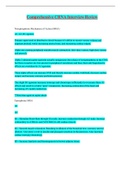
-
Comprehensive CRNA Interview Review Accurate responses are given.
- Presentation • 70 pages • 2023
-
- $18.99
- 3x sold
- + learn more
Comprehensive CRNA Interview Review Accurate responses are given. Comprehensive CRNA Interview Review Norepinephrine Mechanism of Action (MOA) A1, A2, B1 agonist. Primary agent used in distributive shock because it's ability to recruit venous volume and augment preload, while increasing arterial tone, and increasing cardiac output. Alpha one causing peripheral smooth muscle contraction. (low dose venous, high dose venous and arterial). Alpha 2 adrenoreceptor agonism actually ant...

-
Complete Test Bank The Human Body in Health and Illness 7th Edition by Barbara Herlihy
- Exam (elaborations) • 370 pages • 2023
-
- $15.49
- 2x sold
- + learn more
Complete Test Bank The Human Body in Health and Illness 7th Edition by Barbara Herlihy Chapter 01: Introduction to the Human Body Herlihy: The Human Body in Health and Illness, 7th Edition MULTIPLE CHOICE 1. What is the branch of science that studies how the body functions? a. Anatomy b. Histology c. Pathology d. Physiology ANS: D 2. Which word comes from the Greek word meaning “to dissect”? a. Anatomy b. Histology c. Pathology d. Physiology ANS: A 3. Which of the follow...
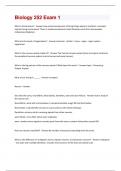
-
Biology 252 Exam 1 Questions And Answers Solved 100% Correct!!
- Exam (elaborations) • 18 pages • 2024
- Available in package deal
-
- $7.99
- + learn more
What is homeostasis? - Answer-how varied components of living things adjust to maintain a constant internal living environment. There is a balanced dynamic state! Diseases result from homeostatic imbalances (diabetes) What are the levels of organization? - Answer-chemical - cellular - tissue - organ - organ system - organismal What is the nervous system made of? - Answer-The Central nervous system (brain and spinal cord) and the peripheral nervous system (cranial nerves and spinal nerves)....
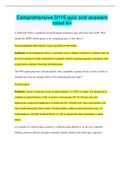
-
Comprehensive D115 quiz and answers rated A+
- Exam (elaborations) • 16 pages • 2023
-
Available in package deal
-
- $9.99
- 1x sold
- + learn more
Comprehensive D115 quiz and answers rated A+ A child with Down’s syndrome has had frequent respiratory tract infections since birth. What should the APRN tell the parent is the underlying cause of this illness? Gastroesophageal reflux disease causes aspiration of thin fluids. Feedback: Gastroesophageal reflux is commonly seen in children with Down syndrome and can be severe enough to result in aspiration of stomach contents, causing respiratory symptoms such as persistent coughing, wheezing, ...
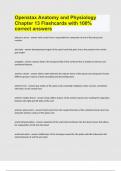
-
Openstax Anatomy and Physiology Chapter 13 Flashcards with 100% correct answers
- Exam (elaborations) • 16 pages • 2024
-
- $14.49
- + learn more
abducens nerve sixth cranial nerve; responsible for contraction of one of the extraocular muscles alar plate developmental region of the spinal cord that gives rise to the posterior horn of the gray matter amygdala nucleus deep in the temporal lobe of the cerebrum that is related to memory and emotional behavior anterior column white matter between the anterior horns of the spinal cord composed of many different groups of axons of both ascending and descending tracts ...
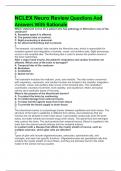
-
NCLEX Neuro Review Questions And Answers With Rationale
- Exam (elaborations) • 48 pages • 2024
-
- $13.49
- + learn more
NCLEX Neuro Review Questions And Answers With Rationale Which statement is true for a patient who has pathology in Wernicke's area of the cerebrum? A. Receptive speech is affected. B. The parietal lobe is involved. C. Sight processing is abnormal. D. An abnormal Romberg test is present. A The temporal, not parietal, lobe contains the Wernicke area, which is responsible for receptive speech and integration of somatic, visual, and auditory data. Sight processing occurs in the occipital lob...
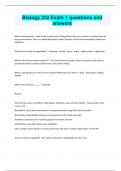
-
Biology 252 Exam 1 questions and answers
- Exam (elaborations) • 17 pages • 2024
-
- $13.49
- + learn more
What is homeostasis? - how varied components of living things adjust to maintain a constant internal living environment. There is a balanced dynamic state! Diseases result from homeostatic imbalances (diabetes) What are the levels of organization? - chemical - cellular - tissue - organ - organ system - organismal What is the nervous system made of? - The Central nervous system (brain and spinal cord) and the peripheral nervous system (cranial nerves and spinal nerves). What is the big p...

How did he do that? By selling his study resources on Stuvia. Try it yourself! Discover all about earning on Stuvia


